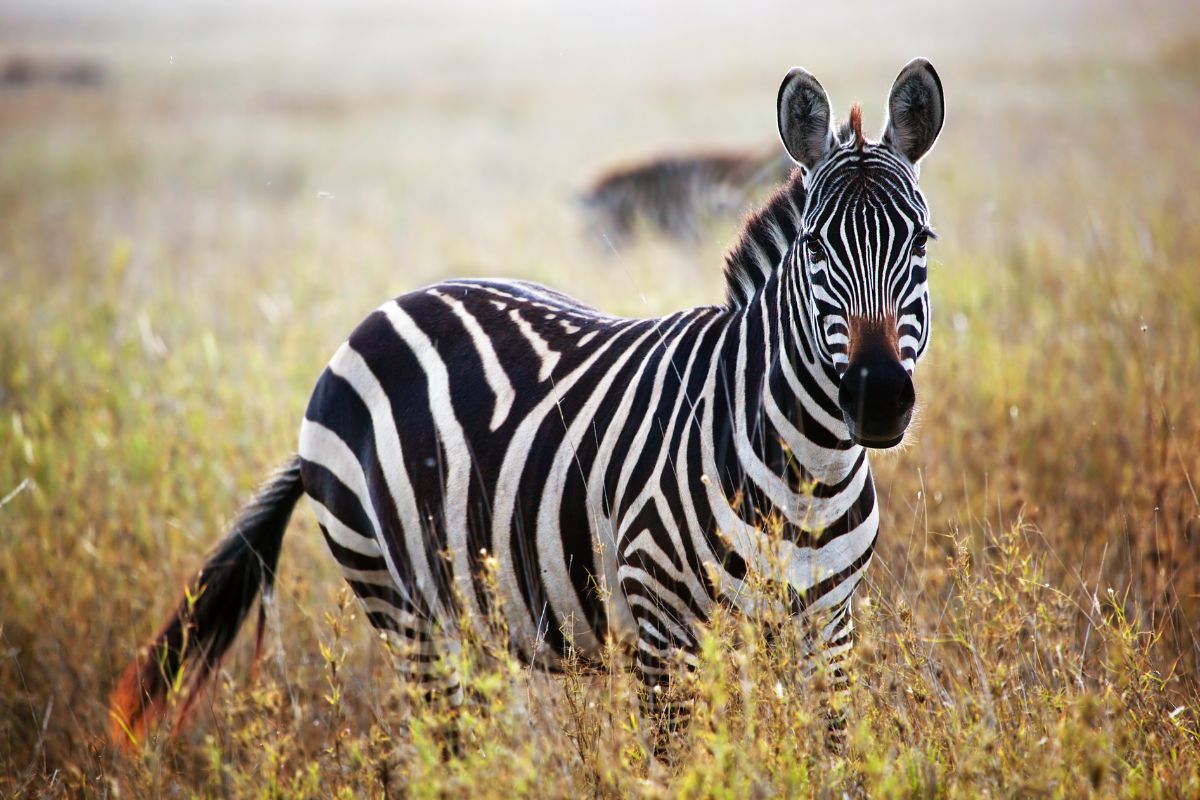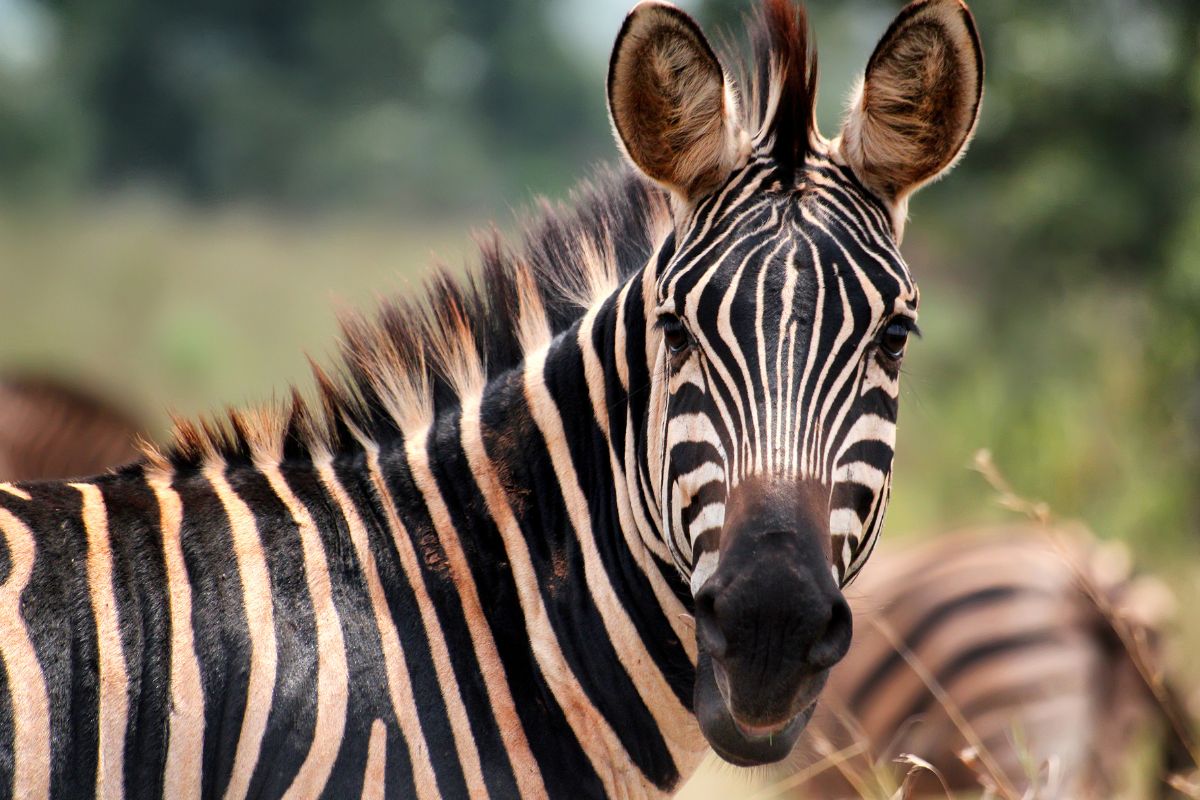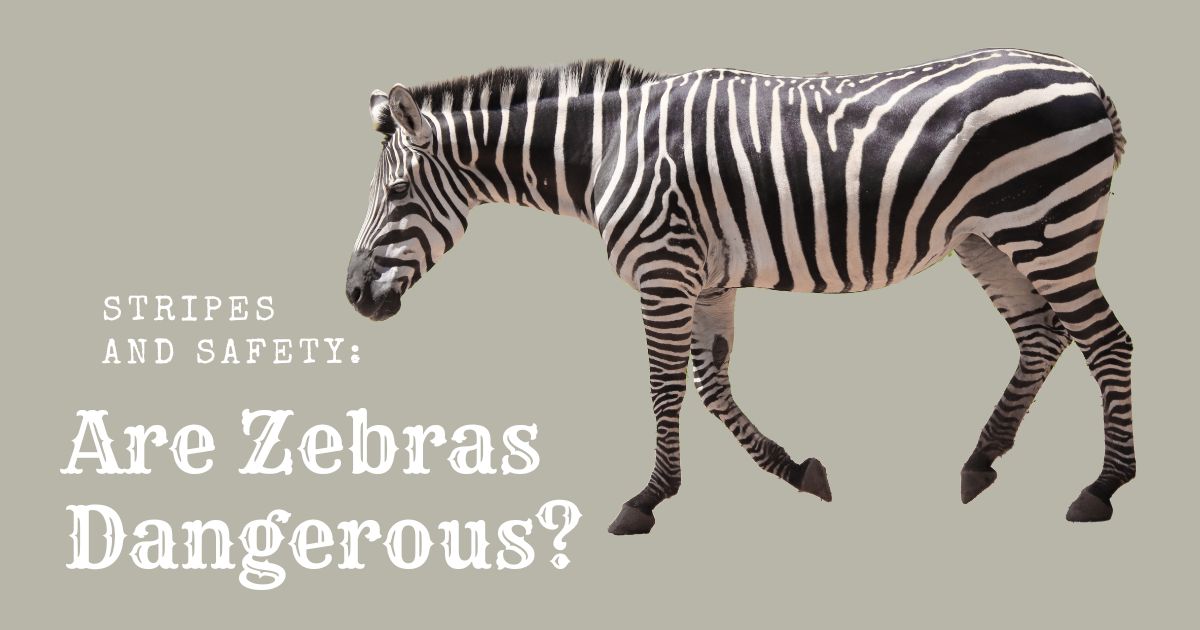Do Zebras Bite?
Do zebras bite? Are zebras dangerous? Zebras have strong front teeth that make them fierce biters. If a predator or person gets too close, zebras will not hesitate to bite. The stories you hear about zebras biting humans are mostly true. However, zebras don’t usually start fights. If you get too close, be ready for their reaction.

Are Zebras Dangerous?
Indeed, zebras are inherently dangerous and do not meet the criteria for domestication. Due to their unfriendly nature, zebras remain predominantly wild. You won’t find zebras employed for load-bearing, farm work, or fence-jumping tasks.
On the other hand, many domesticate horses and donkeys because of their adaptable and friendly demeanor. Zebras, however, refuse to settle for anything less than a wild existence.
So, what makes zebras so dangerous? Despite their seemingly friendly appearance, zebras are among the most dangerous animals. But why is that the case? Let’s consider things from the zebras’ perspective. Survival in the wild is no easy task, especially among large and formidable predators such as lions, cheetahs, and hyenas.
Native to South Africa, zebras have a fight-or-flight response as herbivorous prey animals. To endure a harsh environment, zebras are alert and responsive creatures prepared to fight when necessary.
Having been inhabitants of the wild for thousands of years, zebras have thick skin and are wary of allowing anyone into their social circle. Their defensive nature is a major hindrance to their domestication.
The Zebra Temperament
Zebras have a nervous and cautious demeanor. They are inherently apprehensive animals, primarily motivated by their instinct for survival in the environment. They are usually hyperaware of potential hazards in their environment.
Also, they may exhibit signs of anxiety, such as restlessness, continually checking their surroundings, or stampeding in response to perceived dangers. This attitude is especially noticeable when zebras face predators or humans.
Further, zebras have a complicated social structure and hierarchy regarding social interactions inside their herds. Dominance and submission are essential factors in their behavior, and disagreements may emerge as they establish and retain their positions within the group. This can lead to aggressive behavior among herd members, such as biting and kicking.
Consequently, when engaging with zebras, it is critical to recognize and respect their natural temperament. Approaching them cautiously, giving them space, and avoiding unexpected movements or loud noises can reduce tension and protect the observer’s safety and the zebras’ well-being.
Where are Zebras Found?
You can find zebras mostly in Africa’s grasslands, savannas, and open plains. They are native to Africa, and you can find them in various nations, including Kenya, Tanzania, South Africa, Namibia, Botswana, and Zimbabwe. Each zebra species has a preferred environment.
The plains zebra (Equus quagga) is the most common and exists in various environments, such as grassy plains, woods, and even hilly areas. In more harsh and hilly terrain, you can find mountain zebras (Equus zebra), especially in South Africa and Namibia.
The most endangered species is the Grevy’s zebra (Equus grevyi), primarily in dry and semi-arid areas of Kenya and Ethiopia. Zebras adapt well to open grasslands, where they can graze on grass and scan their surroundings for potential predators. Their prevalence in these areas links to the availability of adequate food sources and the availability of water.
It’s vital to know that zebras aren’t seen in the wild elsewhere than in Africa. However, they may be present in some areas in protected wildlife reserves or zoos where people conserve and promote these amazing animals.
Are Zebras Aggressive?
When frightened, cornered, or guarding their young, zebras become hostile toward humans and other animals. Stallions, or male zebras, are the most aggressive. Zebras are quite sociable creatures that spend time in herds to protect themselves from predators.
These animals live in tiny family groups that include a male (stallion), numerous females (mares), and their offspring (foals). A baby zebra is sometimes called a filly if female and a colt if male.
A zebra harem comprises six breeding mares, their foals, and a dominant male. Young zebra stallions are infamous for attempting to steal mares from other harems to build their own. There is also evidence that zebra stallions can scare pregnant mares from other harems into miscarrying their foal.

Do Zebras Attack Humans?
You may wonder, are zebras dangerous to humans? Zebras do not attack humans unless you provoke or threaten them. On the other hand, zebras are some of Africa’s most deadly in the equine family and can become unpredictable in the wild. As a result, while encountering zebras in the wild, giving them plenty of space is critical.
Furthermore, avoid approaching baby zebras because their mothers may attack to protect them.
If you find yourself in a scenario where a zebra is attacking, the best thing to do is to flee as swiftly as possible. Attempting to fight back will simply worsen the issue. Zebras have tremendous kicking power and powerful bites.
Are Zebras Friendly?
Zebras, in general, are not considered to be friendly animals. They have a natural wariness towards humans and tend to be cautious and skittish in their presence.
Zebras are wild animals and have a strong instinct for self-preservation. They are highly social within their herds but can exhibit defensive behaviors when faced with unfamiliar situations or potential threats, including humans. It’s important to remember that individual zebras may have different temperaments and behavior patterns.
While some zebras may become accustomed to human presence in certain settings, such as wildlife reserves or areas with regular tourist visits, they generally do not seek out human interactions or display the same level of friendliness as domesticated animals like dogs or horses.
Moreover, approaching a zebra in the wild or attempting to interact with one can be risky, as they may perceive humans as a potential threat and react defensively. Observing zebras from a safe distance and respecting their wild nature is always advisable.
Human vs. Zebra – Attack Risk?
The likelihood of a human-versus-zebra attack is normally low. Zebras are naturally shy and fearful of humans in their native habitat. They are usually suspicious of unexpected circumstances, especially human contacts. Instead of engaging in violent conduct, zebras’ primary impulse is to escape.
While zebras are wild creatures capable of displaying defensive instincts when attacked, they are not known for seeking out confrontations or attacking humans without provocation. However, it’s crucial to realize that various zebras have varying temperaments and behavior patterns, and there have been rare incidents of zebras being aggressive toward humans.
Can You Ride a Zebra?
It is not safe to ride zebras for several reasons. Firstly, zebras are wild animals with an instinct for self-preservation. Zebras have different temperaments and are not naturally inclined to carry humans on their backs.
Secondly, zebras have a strong and unpredictable nature. They can exhibit aggressive behaviors, including biting and kicking, especially when they feel threatened or stressed. Attempting to ride a zebra can provoke a defensive response, putting the rider at risk of injury.
Furthermore, zebras have different physical characteristics compared to domesticated riding animals. They have different body structures, gait, and balance, making them less suitable for carrying riders comfortably and safely. Their backs are shorter and less adapted for bearing weight, which can cause discomfort or harm to the zebra and the rider.
Therefore, riding zebras is unsafe due to their wild nature, unpredictable behavior, and physical differences. Appreciating these beautiful animals from a safe distance and respecting their natural habitat is advisable.
Are Zebras Faster Than Lions?
Certainly not; a zebra is no match for a lion. Lions possess a considerable size and strength advantage over zebras, equipped with powerful jaws and sharp teeth. Furthermore, lions typically hunt in coordinated groups, granting them a significant edge over solitary zebras.
Zebras possess limited means of defense against lions, and their primary strategy revolves around attempting to outrun them. Nonetheless, lions can reach up to 50 miles per hour (80.5 kilometers per hour) speeds, making it difficult for zebras to escape their grasp.
Are Zebras More Aggressive Than Horses?
Yes, zebras are more aggressive than horses. They can kick each other so hard that it can result in death, and they bite humans fiercely if they get too close. On the other hand, horses seldom show such aggressive behavior unless you provoke them. This makes zebras more dangerous than horses and certainly more prone to violence.
Are Zebras Afraid of Humans?
Zebras are often terrified of humans. This is due to their natural fear of predators, which increases with the presence of humans. As a result, when approached by a person, they may become stunned or flee. Furthermore, their familiarity with human hunter-gatherers may have strengthened their defensive instincts toward people.
Are Zebras Afraid of Other Animals?
Yes, zebras are afraid of other animals. Lions, hyenas, leopards, and cheetahs frighten them. All of these creatures are predators that prey on zebras. To protect themselves, zebras utilize a high-pitched call to alert the herd when they detect danger.
Can Humans Outrun Zebras?
No, humans are not able to outrun a zebra. Zebras can attain up to 30 miles per hour (48 kilometers per hour) and maintain that pace for up to 12 miles (19 kilometers). They also have remarkable stamina and can run at full speed.
Unless you are an extremely fast runner who can maintain a high speed over extended distances, your odds of outrunning a zebra are minimal.
Why Flies Don’t Bite Zebras
Flies avoid biting zebras because of their distinctive stripes. The stripes operate as camouflage, making it difficult for flies to discriminate between the zebra’s body and surroundings. The lines also create an optical illusion, fooling flies into thinking the zebra is larger than it is, making them less inclined to approach or land on its body.
This striped pattern, known as “disruptive coloration,” helps zebras avoid deadly insects such as horseflies and tsetse flies. Furthermore, some research revealed that specific chemical compounds in a zebra’s coat may play a role in repelling fly attacks.
The Zebra Kick
Zebra kicks are a distinctive feature of their activity. Zebras have muscular legs and may deliver powerful kicks when threatened or need to defend themselves. These kicks defend against predators and other creatures that could harm them.
When a zebra kicks, its powerful hooves can cause catastrophic injury. These kicks are typically intended at the target’s head or body and can be extremely powerful. Zebras kick one another during social interactions, particularly during conflicts or establishing authority within the herd.
Do Zebras Cry?
Zebras, indeed, cry. When distressed or in pain, they create a high-pitched wailing sound. Young zebras typically produce this lament, and one can hear them from afar. Zebras may also make this sound if threatened or afraid.
Are Zebras Mean?
Yes, zebras can be mean. They do not have the temperament to be every little girl’s best friend. They would rather kick you far away if you trespassed in the ‘no access.’ It is impossible to subdue them with flowers, charming discourse, delectable sweets, or pranks.
Other Zebra Vocalizations
Zebras make different sounds which may change depending on the situation. When a zebra gets an injury or a threat, it may let out a short, high-pitched yelp known as a “squeal.” This is common when male zebras get injuries.
A “wail” is a long, drawn-out cry produced by distressed young zebras. Zebras make loud snorts, grunts, squeals, and wails when scared or in danger.

The Final Say
Finally, zebras are intriguing and iconic animals endemic to Africa’s grasslands and savannas. Zebras have unique adaptations that help them thrive in their native settings. They are popular for their characteristic black and white striped coats. They live in herds and exhibit complex behaviors.
Zebras have a wary and timid nature, always on the lookout for potential hazards. Their powerful kicks and strong herding instincts give them effective predator defensive measures.
While zebras are not friendly or domesticated animals, their beauty captivates us, and they are crucial in maintaining the ecological balance of the African savannas.
Understanding and appreciating these amazing creatures helps contribute to conservation efforts to preserve them.

